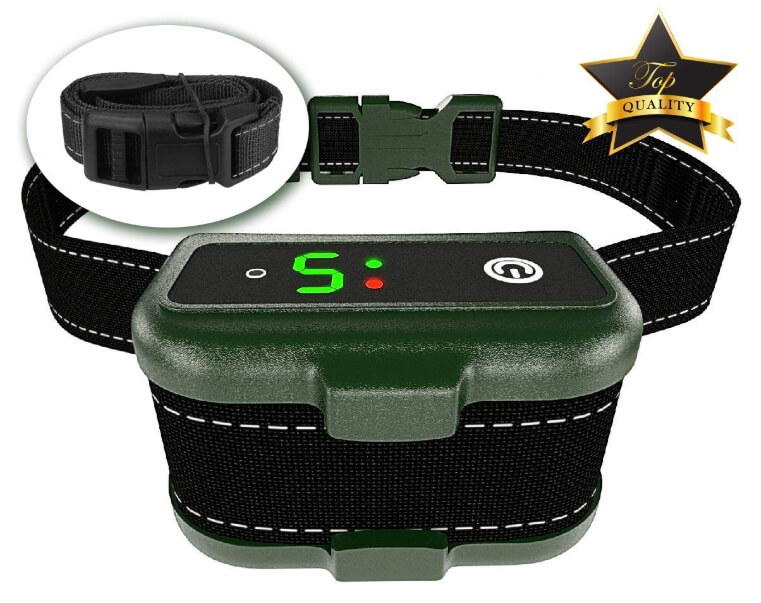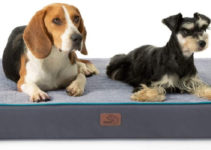This post may contain affiliate links. You can view our affiliate disclosure here.

If your dog chases passing cars, whether it’s your own car or one driving by, you have a problem.
Not only is the dog at severe risk of injury, dismemberment or even death, but the drivers and passengers in the car are at risk as well.
Many accidents occur each year as drivers about to hit chasing dogs try to swerve away, break suddenly or accelerate. Such actions may well be followed by a fatal accident involving the dog, the car being chased, other cars, pedestrians, or objects in the vicinity.
Danger calls whenever a dog lunges towards a passing car. Specific training and other deterrents will be needed to wean them of this habit.
Why do dogs chase cars?
The first thing to realize is that chasing cars — or the closely related behavior of attempting to nip at moving wheels — is not a quirk that your pup has caught on to just to annoy you!
Dogs have “prey instinct”. For thousands of years, wolves and then domesticated dogs developed the inbred ability to track moving prey, be it squirrels, rabbits or foxes.
The dogs’ main advantage was their speed, used to either outrun or tire out their prey.
When you combine a dog’s prey instinct with subsequent breeding by its human masters to emphasize behaviors such as the ability to herd and/or stalk, hunt and fetch prey, the picture becomes clear.
If your dog goes for “the legs”, aka the wheels of a moving car, you should know that it’s their instinct coming to the fore. Plus, dogs love to play, so you can add in their urge to interact with the object moving rapidly away from them.
Which breeds are more aggressive?

Hunting and herding breeds are very prone to chasing cars. For example, hunting dogs such as Greyhounds, Terriers, Pointers, Setters, Retrievers and Whippets have finely honed chase instincts, though their attention may stay on smaller objects.
Dogs trained to herd sheep and cattle, such as Border Collies, Australian Shepherds, Shelties and Corgis may be even more prone to chase or interact with larger objects, from joggers to cars and everything in between.
5 Strategies To Stop Your Dog From Chasing Cars
The remedies you can adopt to cure your dog of car chasing behavior can be put into a few categories:
- Reduce opportunities to chase cars.
- Provide safe outlets for chasing other things.
- Teach your dog to curb its instincts and obey commands, often with positive reinforcement.
- Continue to practice using staged situations.
- Reinforce training with more stringent measures when other approaches do not work.
Now I’ll expand on each of the above points:
1. Reduce Opportunities

There are some common-sense measures that you should adopt as a matter of course:
- Keep your pet in fenced enclosures: Do not leave your dog unattended except in a fenced area. This will reduce worries when you are not around.
- Use a leash: Put your dog on a leash when you take it for walks outside your property. This prevents it from chasing cars or other unwanted objects. Leashes can also be used to restrain a dog that breaks training and lunges at a passing car. Being able to leash walk should be one of the first requirements if your dog goes for frequent walks outside its home environment.
2. Provide Safe Outlets For Chasing Behavior
There are different ways to ensure that your dog doesn’t get bored, overhyped or anxious due to inaction. For example, you can:
- Take your pet for long walks: The more exercise your dog gets, the more its aggression and hyperactivity will diminish.
- Play fetch: Play fetch with your dog in an enclosed area. It’s safe, great fun for the puppy, and alleviates boredom and pent-up energy.
- Dog sports: Enroll your dog in organized dog sports, such as herding trials for Shepherd breeds or go-to-ground for Terriers. This will allow them to work off their urges in a controlled, safe environment.
- Get your dog to chase you: Why don’t you get your dog to chase you, instead of some passing attraction?
3. Train Your Dog To Obey

Besides teaching your dog the basic commands below, some experts suggest that you use a nickname to sharply deliver a command or call it away from a chase, as opposed to calling out its actual name.
If the dog can be taught to unconditionally react to a nickname, the instinct to obey may kick in if it understands that you are not being playful and the situation is different.
- Sit and stay commands: Basic commands such as “sit” and “stay” are absolutely necessary. This should be the first step towards teaching a dog not to chase.
- Leave command: Similar to the “sit” or “stay” commands, teach your dog to “leave” its pursuit of a fleeing vehicle and come back to you.
- Reward good behavior: When your dog learns to ignore temptation and obeys your prompts, be it to sit, stay or leave, provide a treat as a reward. Positive reinforcement is important in many respects.
4. Expose Your Dog To Staged Situations

In order to reinforce all of the above trainings, you must expose your dog to staged situations.
Initially, have your dog on a loose (6 feet) leash as a friend or family member passes by in a slow-moving car.
See if the dog reacts and employ your “Stay” or “Leave” command. If the dog lunges forward, the leash will provide adequate restraint.
Over time, get the passing car to drive by faster, and see if the dog reacts. If it manages to sit still, stay put or leave pursuit, provide rewards intermittently to reinforce the behavior.
Ultimately, you want to get to the stage where the dog may look at a passing car but will be so focused on you that he/she will leave it alone.
Situations can be staged where you and your pet are standing still or seated when the car passes, as well as situations where you are taking your dog for walks when the car approaches. You could also drive by in your own car, leaving the dog in the care of a friend or family member to check on its reactions to various commands.
In all of these staged exercises, the goal is to redirect the dog’s attention towards you and the commands. It may be impossible to eliminate the drive altogether, but the dog’s training should suffice to prevent actual chases.
5. Reinforce Training For Stubborn Dogs With More Stringent Measures
If a dog continues to chase cars in spite of all your efforts, it may be time to resort to harsher measures, such as:
1. Shock Collars
Fit your dog with a shock collar. It won’t make the dog afraid of cars, but a small electric shock will get your dog’s attention and deter negative or unsafe behavior.
Shock collars, when calibrated properly, are safe and will not cause any lasting physical harm.
2. Consulting A Specialist
A canine behavioral specialist will be able to determine breed or behavioral traits that may be causing persistent chasing behavior.
They may be able to either devise training or techniques that you can adopt, or work extensively one-on-one with the pet to help correct its behavior and urges.
Conclusion
It’s a given that dogs have natural instincts. Train them well, but always be on the lookout for signs that indicate they are about to become hyperactive.
Enlist the help of a family member, friend or neighbor to train them. For example, if the dog chases your own car, someone else will need to be present to either reinforce your commands or act to prevent incidents when the pup breaks protocol.
If you are handling the dog, you will need someone else to be the driver of the passing car that your dog should not be chasing.
Having said all this, there may be situations where you can’t get your dog to stop chasing. It might have a prey drive that is too strong, or it might be suffering from more serious issues that you can’t address by yourself.
If you’re really having a hard time training your dog not to chase cars, or you’re simply having problems getting your dog to come when called, you could get the help of a dog trainer. But professional dog trainers and behaviourists can be extremely expensive – something like $500 for three hours, or even more.
Who’s going to pay this amount of money for just 2 or 3 hours of help?
There’s a solution. You can get instant access to a dog training program by a certified dog trainer with over a decade of experience working with clients.
This trainer has figured out that poor recall response from dogs fundamentally comes down to learning how to calm your dog down so it can regain control of its emotions.
And so he’s put together a series of emotional control exercises that have been proven to get your dog to listen to you instead of chasing cars.
This dog training package is substantial, and it costs a tiny fraction of what you would pay for the services of a typical dog trainer.
You can alternatively read my review of the program. Good luck!
Thanks for reading this article. Do you have problems with your dog chasing cars? Feel free to share your experiences or ask questions in the comments below.




